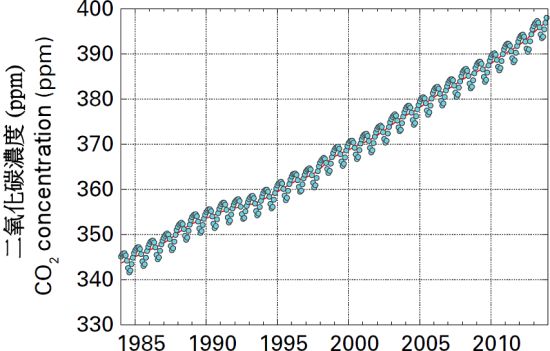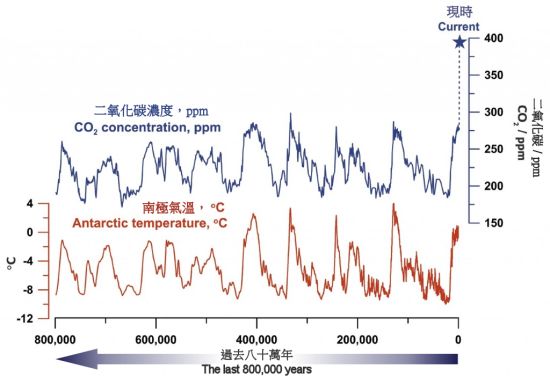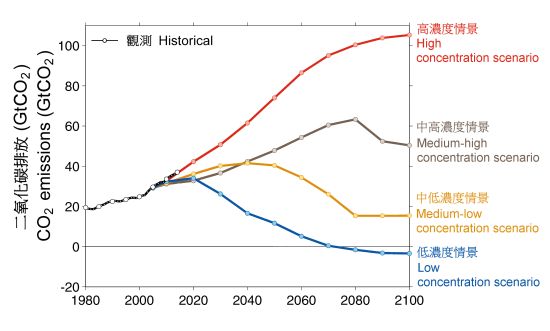Record High Carbon Dioxide Concentration
23 October 2014
In September 2014, the World Meteorological Organization (WMO) released the annual Greenhouse Gas Bulletin[1], announcing that the atmospheric concentration of carbon dioxide (CO2) in 2013 had set a new record of 396 ppm (Figure 1), 42% higher than the pre-industrial level. The annual increase in 2013 was 2.9 ppm, the largest year-to-year change since 1984. At the current rate of increase, the global average CO2 concentration is expected to exceed 400 ppm in the next couple of years.

Analyses of Antarctic ice cores have shown that Antarctic temperature (Note 1) and atmospheric CO2 concentration in the past 800,000 years go hand-in-hand (Figure 2). Variations of CO2 concentration and Earth's temperature are controlled by natural factors including Earth's orbital changes, volcanic eruptions and changes in solar activity. However, such natural variations have apparently been overwhelmed by the human-caused emission of greenhouse gases in recent centuries. As a result, the current CO2 concentration has risen to a level unprecedented in the past 800,000 years.

To estimate possible temperature changes in the future, climate scientists have designed a number of greenhouse gas concentration scenarios (Figure 3) and computed the projected global temperature in the 21st century under these scenarios. It is most alarming that the current CO2 emission has a strong tendency to follow the trajectory of the worst scenario of high greenhouse gas concentration, which will lead to a global average temperature rise of 4oC (compared to the pre-industrial level) by the end of this century. Scientists have warned that a world warmer by 4oC would be marked by intense heat waves, extreme precipitation, and damaging sea level rise.

If we still want to meet the "2oC target" (Note 2), immediate, substantial and sustained reduction of CO2 emissions is required. We cannot afford to procrastinate as the climate system also needs a finite amount of time to re-adjust to the actions we take for a better outcome. "We have the knowledge and we have the tools for action to try to keep temperature increases within 2oC to give our planet a chance and to give our children and grandchildren a future," said Michel Jarraud, WMO Secretary-General. That future is now in our hands.
S M Lee and H W Tong
Note:
1. Climate change FAQ: How do scientists reconstruct the temperature tens of thousands of years ago?
http://www.weather.gov.hk/climate_change/faq/faq_e.htm#Q22
2. At its meeting held in Luxembourg in 1996, European Union indicated that the global mean surface temperature increase should not exceed 2oC above the pre-industrial level to avoid the risk of severe climate change impacts on human and ecological systems. See "Climate change FAQ: What is the "2oC Target"?"
http://www.weather.gov.hk/climate_change/faq/faq_e.htm#Q15
Reference:
[1] World Meteorological Organization Press Release No. 1002
https://www.wmo.int/pages/mediacentre/press_releases/pr_1002_en.html

Figure 1.Global average atmospheric CO2 concentration (source: WMO)
Analyses of Antarctic ice cores have shown that Antarctic temperature (Note 1) and atmospheric CO2 concentration in the past 800,000 years go hand-in-hand (Figure 2). Variations of CO2 concentration and Earth's temperature are controlled by natural factors including Earth's orbital changes, volcanic eruptions and changes in solar activity. However, such natural variations have apparently been overwhelmed by the human-caused emission of greenhouse gases in recent centuries. As a result, the current CO2 concentration has risen to a level unprecedented in the past 800,000 years.

Figure 2.Variations of Antarctic temperature and atmospheric CO2 concentration estimated
from Antarctic ice cores (source: US National Academy of Sciences)
from Antarctic ice cores (source: US National Academy of Sciences)
To estimate possible temperature changes in the future, climate scientists have designed a number of greenhouse gas concentration scenarios (Figure 3) and computed the projected global temperature in the 21st century under these scenarios. It is most alarming that the current CO2 emission has a strong tendency to follow the trajectory of the worst scenario of high greenhouse gas concentration, which will lead to a global average temperature rise of 4oC (compared to the pre-industrial level) by the end of this century. Scientists have warned that a world warmer by 4oC would be marked by intense heat waves, extreme precipitation, and damaging sea level rise.

Figure 3.CO2 emissions associated with different greenhouse gas concentration scenarios
shown in coloured lines. Historical observations are shown in black.
(source: Global Carbon Project)
shown in coloured lines. Historical observations are shown in black.
(source: Global Carbon Project)
If we still want to meet the "2oC target" (Note 2), immediate, substantial and sustained reduction of CO2 emissions is required. We cannot afford to procrastinate as the climate system also needs a finite amount of time to re-adjust to the actions we take for a better outcome. "We have the knowledge and we have the tools for action to try to keep temperature increases within 2oC to give our planet a chance and to give our children and grandchildren a future," said Michel Jarraud, WMO Secretary-General. That future is now in our hands.
S M Lee and H W Tong
Note:
1. Climate change FAQ: How do scientists reconstruct the temperature tens of thousands of years ago?
http://www.weather.gov.hk/climate_change/faq/faq_e.htm#Q22
2. At its meeting held in Luxembourg in 1996, European Union indicated that the global mean surface temperature increase should not exceed 2oC above the pre-industrial level to avoid the risk of severe climate change impacts on human and ecological systems. See "Climate change FAQ: What is the "2oC Target"?"
http://www.weather.gov.hk/climate_change/faq/faq_e.htm#Q15
Reference:
[1] World Meteorological Organization Press Release No. 1002
https://www.wmo.int/pages/mediacentre/press_releases/pr_1002_en.html